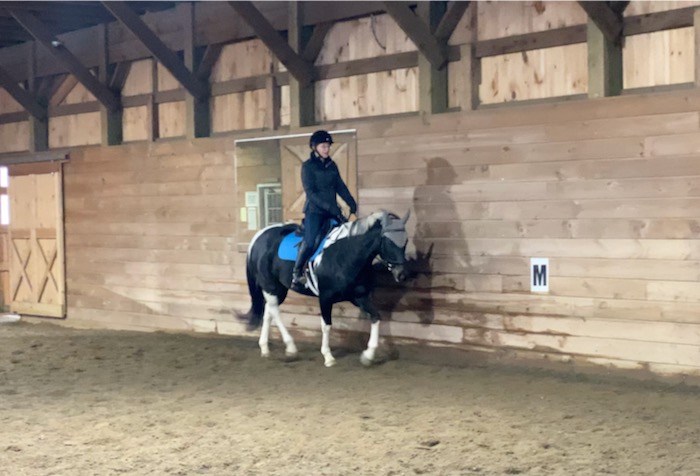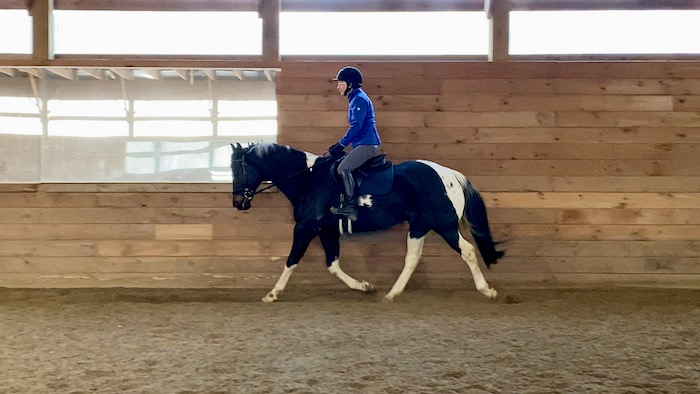I’ve been exercising using videos. Some cardio. Some easy yoga. I’ve tried at least a dozen YouTube channels and have checked out many others. The instructors are super upbeat, but there’s something they all do that is insidiously counterproductive to their optimistic you can do it tone. If only these exercise instructors would make a small tweak in how they word their workouts it would make a world of a difference to their viewers. What they could do differently is glaringly obvious to me because I’ve been schooled in positive animal training and a bit of Tag Teach. I wish they’d turn don’t into do.
I often hear don’t in these phrases during the workouts:
Don’t worry about getting this perfect.
That’s supposed to be encouraging, however, I don’t know about you, but being told not to worry has never stopped me from being anxious! What emotion am I supposed to have when being told to stand on one leg while bending over?
Don’t forget to breathe.
Is it just me, or does hearing that make you gulp? Another issue with the don’t do that phrasing is it isn’t timely. By the time the trainer says don’t forget to breathe, you’ve already done a full 2 jumping jacks while holding your breath! That don’t forget phrase irks me. There’s an admonishing tone to it. You could leave it off altogether and simply say what it is that needs doing.
Then there are the instructions that start with something they don’t want you to do. Don’t press your foot against your knee.
Where should I put it?
Here are better alternatives for the above directives:
It’s okay to lose your balance.
Breathe with each step.
Place your foot on your calf or thigh.
It doesn’t matter how positive you intend to be, if you start a sentence with don’t, the learner’s gut reaction will be to retreat. Here’s an example from my riding. My hands are forever falling into the wrong position. I round my wrists and hold my hands so that I can see my knuckles. Here’s a photo of how that looks. I’m embarrassed to show it to you, but there it is. In a blurry screenshot to cover up a bit of it!

When my trainer says don’t curl your wrists I bring my thumbs up, but first there is self-recrimination. I’ve been trying to correct this for ages and I’m still caught out with those hands in the wrong place and the reins too long. AGGHH! Worse yet, although I’ll get it right for a moment, the correction doesn’t stick. To get a lasting fix (which I was close to before having to take this hiatus from the barn) I had to do more than hear don’t do that! Hands are complicated bits of anatomy, and what I’m asking of them, when holding the reins, is complex. I had to break down exactly what was going wrong and identify how to fix it. My reins were too long. I’d shorten the reins, and seconds later, there they’d be, too long again. Why? The weak link were my pinkies. If they were open, then the muscles in my hands weren’t staying closed on the reins. Telling myself pinkie to palm fixed that. Next, I needed to get those knuckles perpendicular to the ground. I came up with this: thumbs to ear tips. If the fingernails on my thumbs are pointing at the tips of my horses ears, everything else falls into position! Coming up with these proactive phrases enabled me to change my position without that negative self-talk that comes with hearing don’t.
Here’s a screen shot of a moment when I felt my wrists curl. Instead of telling myself don’t do that, I thought, do this. I closed my pinkies and pointed my thumbs to my horse’s ears. I was super quick with the response because there was no frustration to slow it down. Tonka appreciates it when I’m not frustrated with myself. He notices every mood, even if it’s a flicker of negativity. This approach of focusing on the do worked. I’m smiling, and so is Tonka.

Can you think of how you can turn a don’t into a do?


Great advise and something I learned in golf
Never say don’t raise you head instead say watch your hands pass through contact. Positive corrections always work best
The only golfing that I do is miniature golf 🙂 Next time I’ll use your little nugget of advice!
Looking at the second jump, or the arena fence, definitely works better for me than “don’t look at the jump,” which makes me look at the thing I am not supposed to look at. 🙂 Right now, I am trying to focus on keeping my heels down when going into two-point, and feeling the stretch to know that they are down.
“Feeling the stretch” is brilliant. Much better than saying heels down because you know it when you’ve done it. It’s like my “pinkie to palm” thing. I can feel that. Somehow, I don’t feel it if my hands are closed on the reins.
I was told ‘Hold the reins like an ice cream cone.’ 21 years later I still use that analogy as a reminder to self. 🙂
I’m new to your website and just love the insights, honesty and joy you share. ALL of our trail riding options here in western Washington are closed right now, both public and private timber lands. Thanks for brightening these difficult days!
I hadn’t heard that ice cream cone analogy. It’s excellent! I’ve heard holding teacups – but who holds two teacups? Then again, who holds two ice cream cones? 🙂 Actually – I have when my kids were little.
PS It’s good to hear from a new reader! It’s a shame that the public lands are closed. At least I can hike where I am.
I have a fantastic trainer and was able to move to the little private barn she manages last September. She uses your “thumbs pointing to horse’s ears” visual, which I love. She also phrases her suggestions as “What if you….?” “What if you turned the thumb on your inside hand towards the middle of the arena for a couple of strides. What happens then?” “What if you stepped into the inside stirrup?” Turning it into a question helps me not just do what she’s asking, but focus on what happens when I do it. Does the horse I’m riding suddenly bend around my inside leg instead of bulging the shoulder out? Does the trot get “bigger” without speeding up? And when I’m working on something and it’s hard, often she’ll let me figure it out, but she always says, “Good struggle,” so I know I’m on the right track. I love that. It’s really freed me up to try using my body in different ways and pay attention to what happens to my horse when I do so, thus making me a much more independent rider. Positive reinforcement works. Positive phrasing works. And encouraging the rider to experiment and “feel” the results is wonderful.
Shannon, please tell your trainer that I *love* the “what if?” way to train and I will use it as soon as I’m able to see clients again.
The word DON’T always makes you want to DO 🙂
Yes, and often not what the teller wants you to do!
Excellent. Thank you.
🙂
I’m a little behind in commenting – but wanted to say that this is SO important. Thank you for discussing it. It not only focuses on what TO do; it also makes a more fun and much friendlier atmosphere, which relaxes everything.
Another example: My tai chi instructor had mentioned months ago that – even after six years – I have a slight forward lean. He doesn’t nag, so it was only in my mind that I heard “Don’t lean”. The other day I was practicing with my shadow, and finally saw that darn forward tilt. It was minuscule, but present. I pushed my hips forward a half inch, and voila! Now my mantra is “Hips forward”, and the lean is gone.
Again – hugely important topic, well-written as always. Thank you!
Brilliant solution! I also see it as “domino teaching” (I blogged about that awhile back.) The last domino isn’t the one to address. Rather, it’s the one that sets it all in motion.